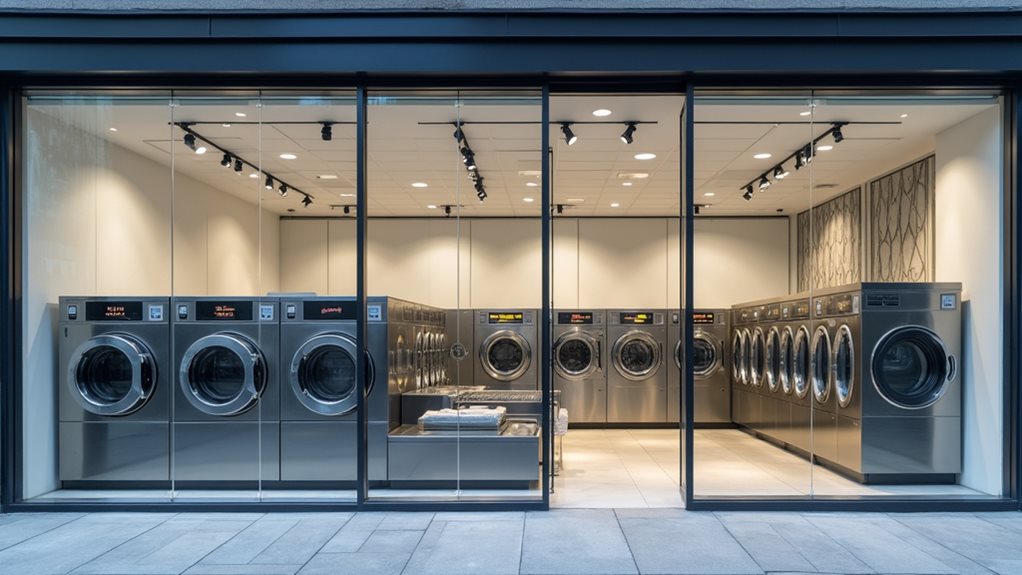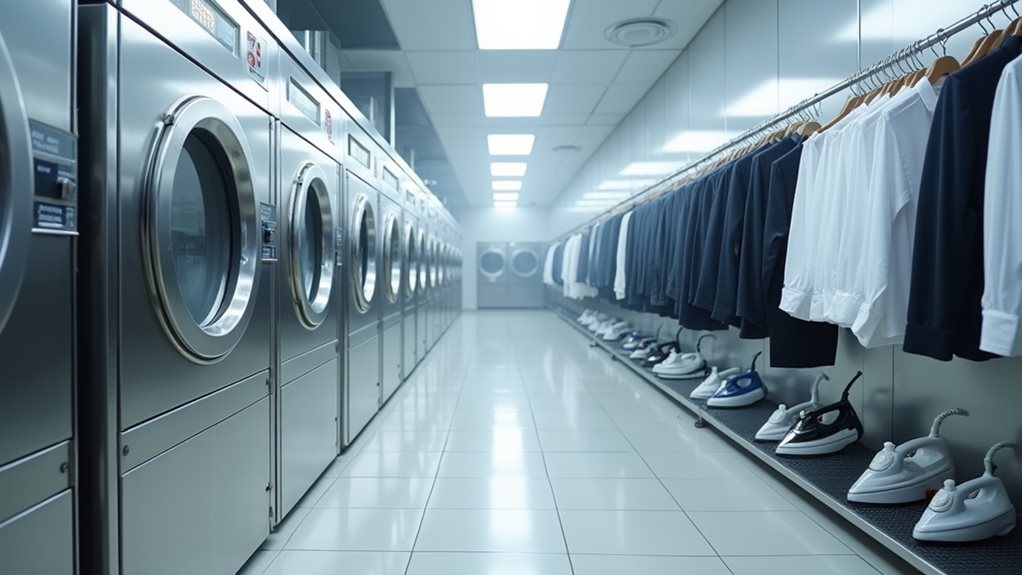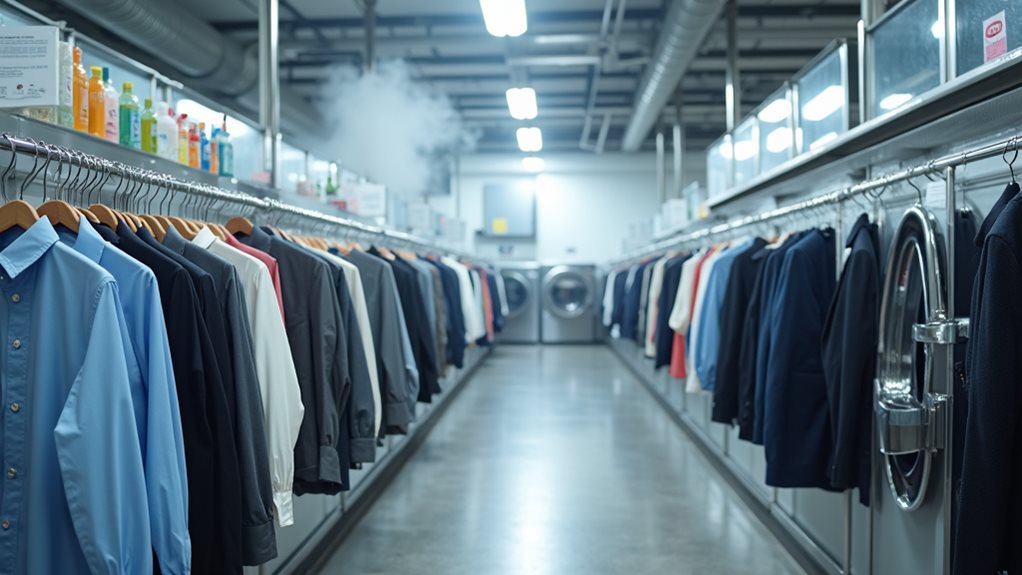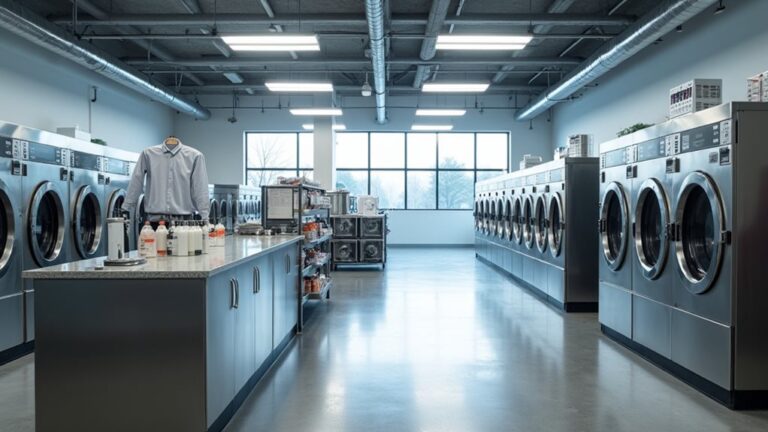Starting your dry cleaning business feels overwhelming at first, but you’ll need to focus on five key areas that’ll set you up for success. Begin with thorough market research to understand your local customers—whether they’re busy families or eco-conscious millennials—then establish your LLC and secure proper licensing, which typically costs $5,000-$15,000. Choose a visible location near shopping centers, invest in commercial-grade equipment ($50,000-$200,000), and develop quality service standards that’ll keep customers coming back. The path ahead reveals proven strategies that transform newcomers into profitable business owners.
Market Research and Target Customer Analysis
Why do some dry cleaning businesses thrive while others struggle to keep their doors open, even in the same neighborhood? The answer lies in understanding your customer base through solid market research, and trust me, I’ve seen too many entrepreneurs skip this vital step 😅.
Success in dry cleaning isn’t about location—it’s about knowing your customers better than your competition does.
You’ll want to identify your target demographics—families juggling soccer practices, busy professionals racing between meetings, and millennials who’d rather spend weekends exploring than doing laundry.
Analyze competitors to spot service gaps, whether that’s eco-friendly cleaning or specialized garment care for delicate fabrics. Understanding local demand and price sensitivity helps you position competitively, while building relationships with local businesses creates steady revenue streams.
The luxury garment care segment has shown particular growth potential despite industry challenges from changing fashion trends toward more casual clothing and remote work impacts.
Don’t forget gathering customer feedback through surveys—it’s your roadmap to success.
Business Registration and Legal Structure Setup

Once you’ve mapped out your customer terrain and competitive positioning, the reality of paperwork hits you like a pile of wrinkled shirts on Monday morning 📋.
Your business registration process starts with choosing the right legal structure, and honestly, an LLC often makes the most sense for dry cleaners since it shields your personal assets from business liabilities while keeping operating procedures relatively simple.
You’ll need to file with your Secretary of State, secure business licenses and permits specific to dry cleaning operations, and don’t forget about liability insurance – trust me, when you’re handling someone’s $500 silk blouse, coverage becomes your best friend.
Budget for business licensing and permits to cost between $5,000 to $15,000 as part of your initial startup expenses.
Keep your business plan handy throughout this compliance maze, because every form seems to ask similar questions about your venture.
Location Selection and Equipment Investment

After surviving the paperwork gauntlet, you’re probably thinking the hard part’s over, but finding the perfect location feels like dating in your thirties – you know exactly what you want, yet everything available seems to have at least one dealbreaker 🏢.
Location selection demands ruthless prioritization, focusing on commercial space near shopping centers where visibility draws customers naturally. You’ll need ample parking for customer convenience, plus compliance with zoning regulations and business permits before signing anything.
Location is everything – prioritize visibility over square footage, because the best equipment won’t save you from an invisible storefront.
Equipment investment hits harder than expected – those commercial dry cleaning machines aren’t cheap, but skimping here means higher operational costs later. Commercial-grade dry cleaning equipment typically runs between $50,000-$200,000, making it one of your largest startup expenses alongside facility costs. Budget for regular maintenance too, because nothing kills profits faster than broken equipment during busy seasons.
Trust me, I’ve watched businesses crumble from poor location choices and unreliable machinery.
Service Offerings and Quality Standards

Three core service pillars will make or break your dry cleaning reputation: variety, reliability, and that extra touch customers remember long after pickup 🧥.
Your dry cleaning services need specialized treatments for delicate fabrics, because trust me, ruining someone’s wedding dress isn’t exactly a five-star review generator.
Implementing a tracking system transforms your cleaning process into something customers actually trust, giving them real-time updates instead of mysterious disappearances.
Staff training on customer service and garment care isn’t optional—it’s your lifeline to a diverse customer base.
Expand your service offerings beyond basic cleaning; repairs, tailoring, and household items create differentiation that competitors can’t ignore.
Most importantly, gather feedback religiously, because your customers’ voices guide service quality improvements better than any business guru ever could.
Premium services like alterations and specialty cleaning command higher prices and can significantly boost your profit margins beyond basic dry cleaning offerings.
Marketing Strategies and Customer Retention

Seven powerful marketing strategies can transform your dry cleaning business from neighborhood necessity into community favorite, but here’s what I learned the hard way: throwing money at random advertisements feels like feeding quarters to a broken arcade machine 🎮.
Smart customer retention starts with a loyalty program that boosts repeat business by 5-10%, while targeted advertising through social media platforms connects you with 73% more engaged customers.
Smart loyalty programs deliver 5-10% more repeat customers while social media targeting creates 73% deeper customer engagement.
I’ve watched businesses flourish by offering first-time promotions like 20% discounts, participating in community events that 70% of consumers actually care about, and sending personalized coupons through direct mail campaigns yielding 13% returns.
These marketing strategies don’t just attract new customers; they create lasting relationships that sustain your business. Successful dry cleaners that focus on quality service and convenient locations can maintain steady revenue streams while achieving solid returns on investment over time.




